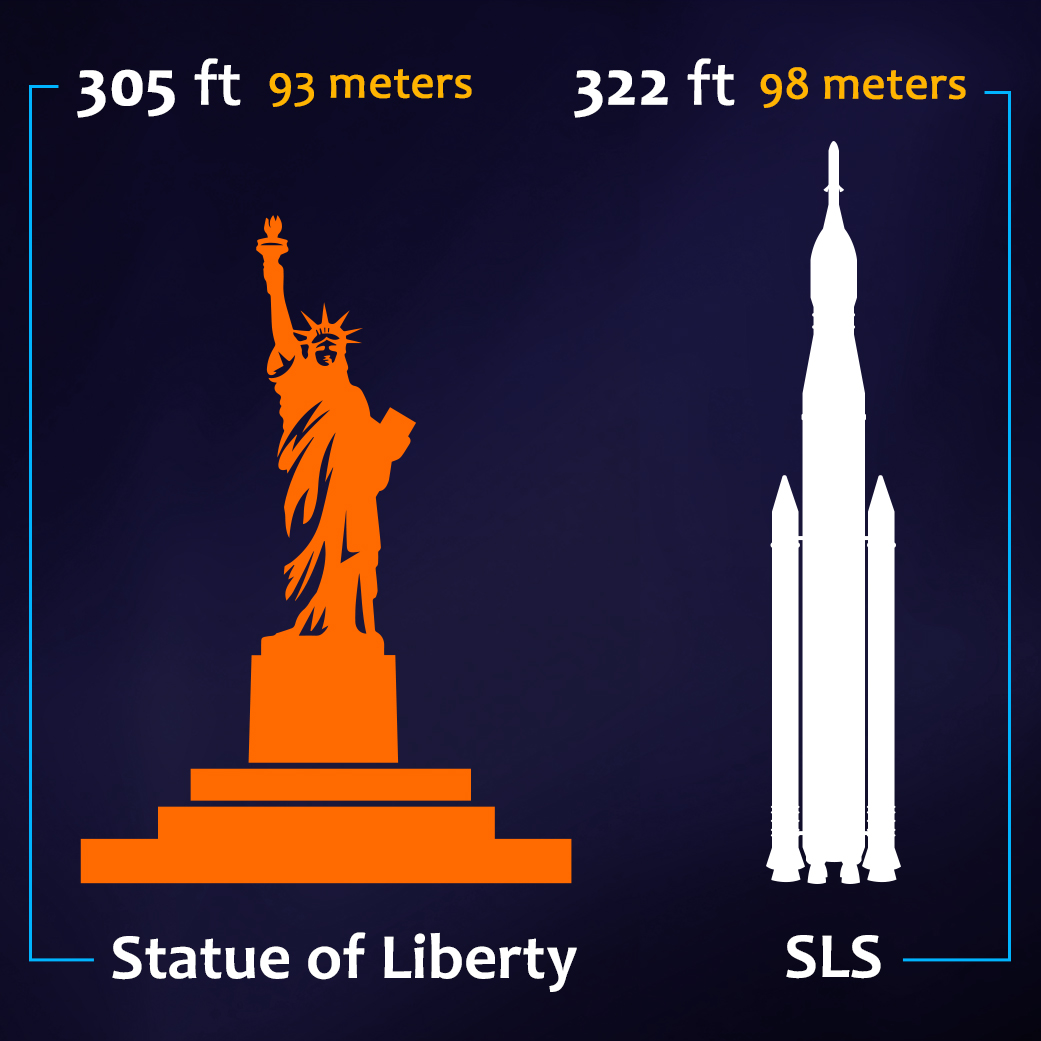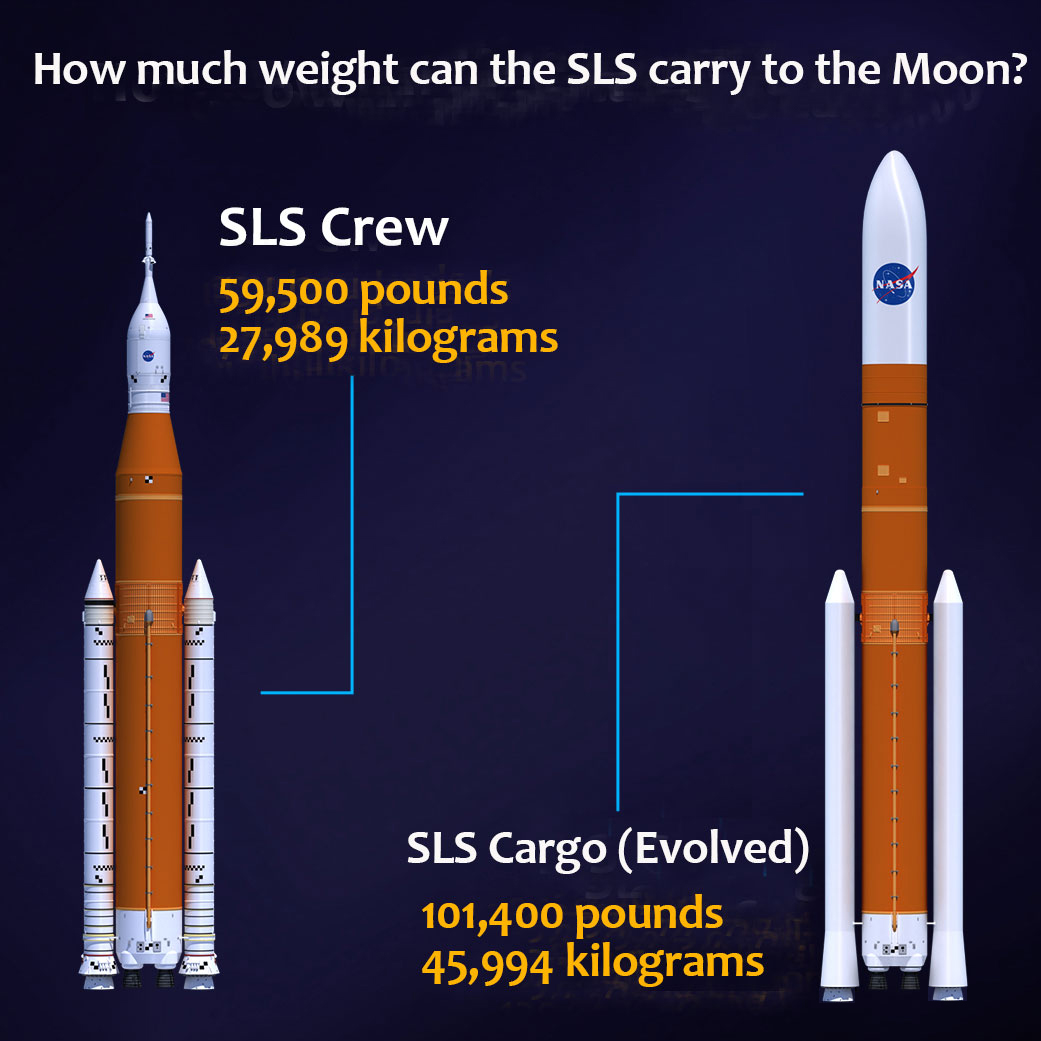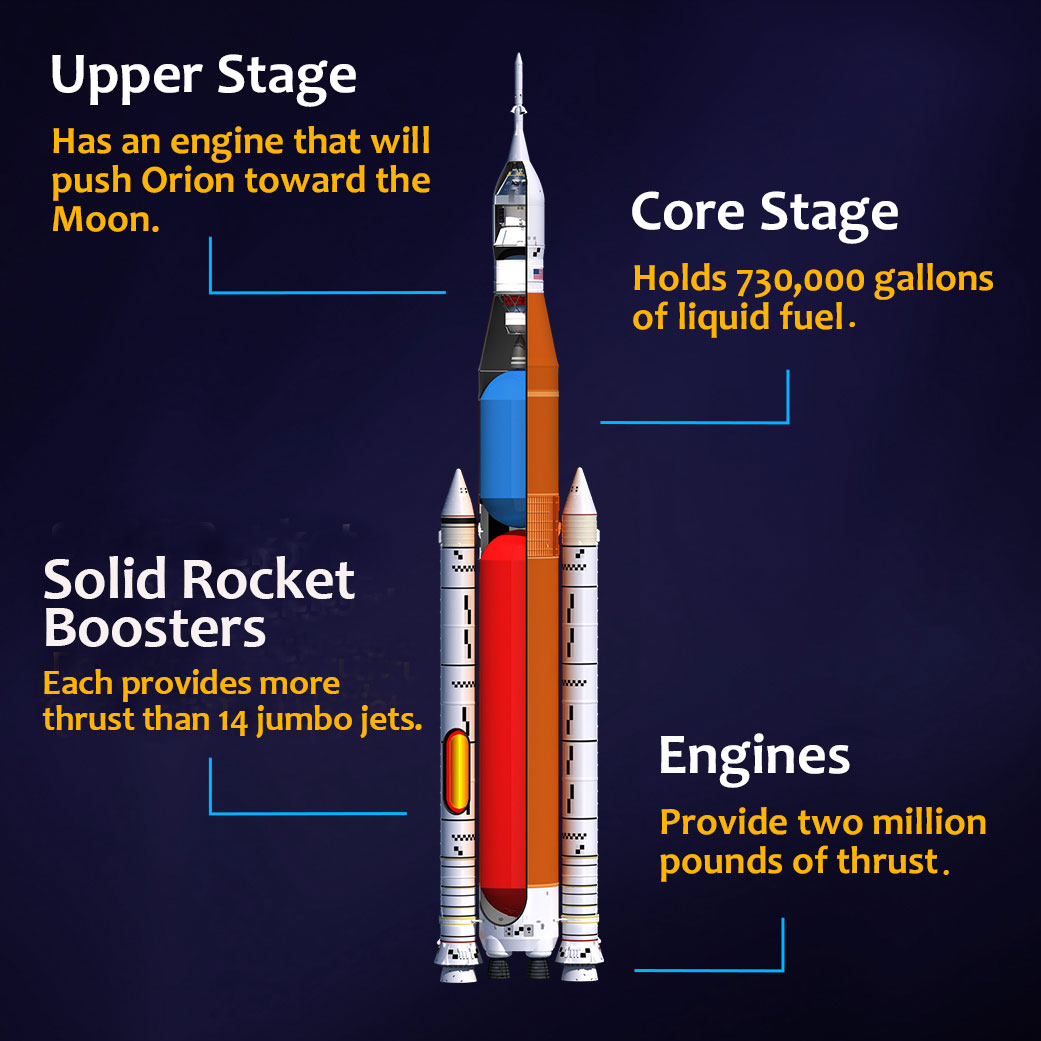This article is for students grades 5-8.
The Space Launch System (SLS) is NASA’s newest rocket. It is a type of rocket called a super heavy-lift launch vehicle that will carry astronauts to explore farther in space than ever before. The rocket is an important part of NASA’s Artemis missions that plan to send the first woman and first person of color to the Moon.
How Big Is SLS?
On the launchpad, SLS will stand taller than the Statue of Liberty and will weigh almost 6 million pounds (almost 3 million kilograms). That’s the weight of eight fully loaded 747 jumbo jets. The SLS crew rocket is powerful enough to carry the weight of 12 NFL football teams of 53 players each.
____________________________________________________________________________________________
Words to Know
cargo: goods carried on a large vehicle
____________________________________________________________________________________________
How Is SLS Designed?
Rockets come in many sizes. Some rockets are more powerful than others. Launch vehicles are rockets that can send people, satellites, spacecraft, or science equipment into space. Super heavy-lift rockets are the most powerful rockets. SLS is a super heavy-lift rocket. When it launches, it will carry more than any rocket in the world. It will launch the Orion spacecraft off Earth so that Orion can carry astronauts to the Moon.
The SLS has four main sections:
- The upper stage that sits under Orion.
- The orange core stage.
- The two white solid rocket boosters
- The four engines that are at the bottom of the core stage.
NASA tests all the parts of SLS to be sure it will fly safely.
SLS will be the most powerful rocket that NASA has ever built. It will carry more cargo and have more energy than any rocket in the world. The SLS is made so that it can be converted for different missions. Not only will the rocket be able to send Orion with a crew of astronauts to the Moon, but a different version of the rocket can send large and heavy equipment to the Moon or even farther to planets like Mars. The different versions of the SLS will be different heights and able to carry different amounts of cargo. Some versions will carry a crew and some only cargo.
____________________________________________________________________________________________
Words to Know
deep space: the vast region of space that extends beyond the Moon and across the solar system
thrust: the forward or upward force produced by the engines of an airplane or rocket
____________________________________________________________________________________________
What Will the SLS Do?
SLS is designed for deep space missions. The rocket will not go to the Moon but will give the Orion spacecraft the push it needs to send a crew of astronauts and cargo to the Moon.
At launch time, a clock counts down to 00 hours, 00 minutes and 00 seconds for liftoff at NASA’s Kennedy Space Center in Cape Canaveral, Florida. After the countdown ends, the clock starts counting up as the SLS rocket and Orion spacecraft travel to space.
Click the times below to see the pictures.
00:00:02—SLS uses 8.8 million pounds of thrust to launch.
00:02:00—The rocket is high above Earth. The solid rocket boosters fall off when the fuel inside them is used.
00:03:40—SLS is 57 miles (91 km) above Earth. Orion is safely in orbit and no longer needs the launch abort system.
00:08:14—The orange core stage is no longer needed and drops off. Only the upper stage of SLS remains to push Orion higher.
01:25:00—Orion is 373 miles (601 km) above Earth. The upper stage engine speeds the rocket from 17,500 mph (28,164 kph) to its top speed of 24,500 mph (39,429 kph).
01:53:00—In less than two hours, Orion is 2,392 miles (3,850 km) above Earth. The work of the SLS rocket is finished. The upper stage separates and burns up. Orion completes the trip to the Moon without SLS.
How Fast Is SLS?
The SLS rocket will travel at a top speed of over 6 miles per second/9.7 km per second. This is so fast that SLS could:
- Go from New York City to San Francisco in eight minutes.
- Travel from Nashville, Tennessee, to Paris, France, in 11.5 minutes.
- Circle the world in 66 minutes.
What Are the Plans for SLS?
The first SLS mission is planned for 2021 and is called Artemis I (Roman numeral 1). The mission will be a test flight for the first time SLS launches, along with the Orion spacecraft. Orion will not have astronauts aboard but will fly around the Moon and back.
On the next mission, Artemis II (Roman numeral 2), SLS will launch Orion carrying a crew of four astronauts. Orion will fly past the Moon and back. Artemis II will be the farthest humans have ever traveled into space.
On the Artemis III (Roman numeral 3) mission, SLS will launch with Orion taking four astronauts and cargo to study the Moon’s South Pole.
Why Is the Space Launch System Important?
NASA’s goal is to discover more about the universe and use that knowledge to help all people. As the space agency sends telescopes, equipment and even astronauts farther into the solar system, NASA must use the best ways possible to reach its goals. SLS is designed for human missions and will allow NASA to send more equipment into space because it is a powerful rocket. Missions at the Moon will help NASA prepare to send astronauts to Mars. SLS will have the power to carry the crew and their supplies, or the large and heavy equipment needed to explore the Moon and Mars.
More About the Space Launch System
Build an SLS Model With School Supplies
Heavy Lifting Activity From NASA STEM: Forward to the Moon
What Is the Artemis Program?
What Is Orion?
Puzzle Book
Poster: SLS: Meet the Rocket
Video: Artemis I – Pushing Farther Into Deep Space
Video: 3, 2, 1… Lift-Off of the Artemis 1 Mission to the Moon
Video: How We Are Going to the Moon
Video: Rocket Science in 60 Seconds: What Is the Space Launch System?
Video: To the Moon and Back: The Journey of Artemis I






























